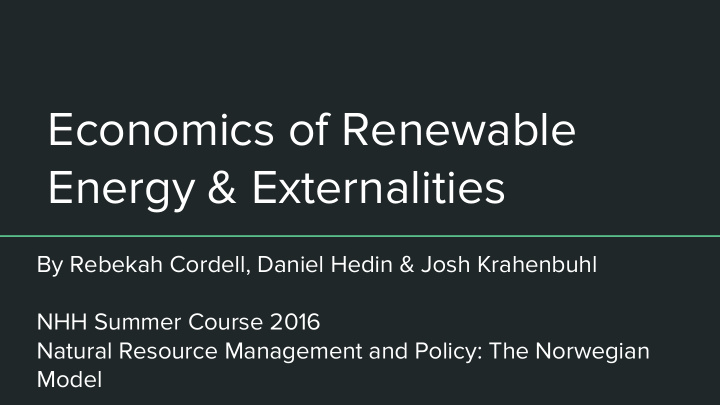



Economics of Renewable Energy & Externalities By Rebekah Cordell, Daniel Hedin & Josh Krahenbuhl NHH Summer Course 2016 Natural Resource Management and Policy: The Norwegian Model
Energy Sources on the market Non-renewables: Crude Oil, Coal, Natural gas, Uranium (nuclear) Renewables: Solar, Hydro, Wind, Geo-thermal, Wave Costs and benefits of each
Topic Discuss arguments for and against public policy support to renewable energy, derived from the economic theory of externalities.
Study Questions: • Has government support of renewable energy projects been effective? And should support be continued?
Introduction Why is this important? Discussing the issue of what’s happening on planet Earth in regards to energy, the environment, emissions, fossil fuels Energy sources on the market What are the important questions?
We are...
Rebekah Cordell Master of Business Administration, Social Enterprise and Finance Master of Arts, International Environmental Policy (December 2017) Institution: Middlebury Institute of International Studies, CA, USA Hometown: State College, PA
Dan Hedin “Daniel” Master of Arts, Applied Economics (August 2016) Institution: University of Cincinnati, Cincinnati, OH USA Hometown: Oregon, Wisconsin
Josh Krahenbuhl Master of Arts, Applied Economics (August 2016) Institution: University of Cincinnati, Cincinnati, OH USA Hometown: Cincinnati, OH
Why a reliance on fossil fuels are bad for society Health Care US library of Medicine estimates $361-886 Billion on Health Care SO2, NOx Destruction of the land, and water Acid Rain Effects corp lands Smog Tapped in the City Masks in China
Economic theory of externalities An externality is a cost generated by one agent that affects the actions of another agent in the economy Fossil fuel use tends to generate negative, rather than positive, externalities Fossil fuel subsidies that encourage wasteful consumption are slowly being decreased as time goes by
Global energy consumption by source, 2011
International growth of renewables ● Such technologies can contribute to energy security if their utilization reduces the need for fossil fuels ● However, few renewable energy programs are competitive without public policy support ● Specific policy instruments such as carbon tax, feed in tariffs and feed in premium are heavily relied upon
Norway . Public policy support Research Wind and Hydropower
Public policy support in Norway The transition away from fossil fuels depends on public perception of new technologies Most individuals are reluctant to pay more for energy generated from renewable resources Voters’ political preferences and their attitudes towards renewable energy Hydro: history of waterfalls, industrial plants
Why it matters in Bergen Smog during the winter Norway ranked 32th in CO2 emissions per capita in 2009
Wind power
Wind power in Denmark Wind energy is expected to contribute the highest share of renewable energy, among all sources Less negative environmental impact wind farms pose landscape and/or seascape disamenities
Issues with the Denmark wind energy Spatial clustering Plants are running at a loss Decay of fossil fuel plants
California Renewable Energy Policy • California has committed to cutting emissions by 40% of 1990 levels by 2050 • A cap and trade program allow a within industry trading system • Realized many successes in reduction to GHG’s • Faces financial, legal and political troubles
Solar Energy in Germany Successful integration of renewable energy, especially Solar 1.5 million Photovoltaic systems all over the country Germany utilizes the policy mechanism of feed-in- tariffs Goal to cut costs radically
International growth of renewable • Marginal cost to produce is zero for an extra KWH • Creation of a new market and new industry • Benefits come by increased trust and utilization • Proof policy matters
Successes... Job market in the US 75,000 wind energy jobs were created 250,000 hydroelectric Estimated 3-1 renewable jobs vs fossil fuel jobs Helps develop rural communities Land rent Initial land subsidies
Future Ventures Concentrated Solar Power Vast improvements in capacity Israel Wave Energy Portugal built the first 2008 UK, USA, Australia Their own challenges Converting UV rays into energy The effects of wave plants on marine wildlife
...and Challenges Solar Energy Labs vs reality Wind Energy Start up cost vs that of a coal plant Thinking Globally
What now? • Policy Matters • Look at what you have • Benefit in keep going with renewable technologies • Canada
Looking forward • Do the research • Potential for unforeseen negative externalities with renewable technologies • In what other ways we combat the inevitable devastations associated with climate change?
Conclusion - Resources & thank-yous Owen, Anthony D. “ Renewable energy: Externality costs as market barriers. ” School of Economics, The University of New South Wales http://www.ceem.unsw.edu.au/sites/ (22 June 2016). NHH… All of you!
Questions?
Recommend
More recommend